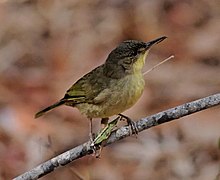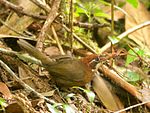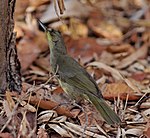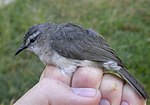|
Bernieridae
The tetrakas, also known as the Malagasy warblers, are a recently validated family of songbirds. They were formally named Bernieridae in 2010. The family currently consists of eleven species (in eight genera) of small forest birds. These birds are all endemic to Madagascar. In 1934, the monophyly of this group was proposed by Finn Salomonsen but the traditional assignments of these birds were maintained, mistaken by their convergent evolution and the lack of dedicated research. The families to which the Malagasy warblers were formerly assigned—Pycnonotidae (bulbuls) and even more so Timaliidae (Old World babblers) and the Old World warbler—were used as "wastebin taxa", uniting unrelated lineages that were somewhat similar ecologically and morphologically. It was not until the analysis of mtDNA cytochrome b and 16S rRNA[2][3] as well as nDNA RAG-1 and RAG-2 exon sequence data,[4] that the long-proposed grouping was accepted.[5] Taxonomy and systematicsThe family contains 11 species divided into 8 genera.[5]
The first phylogeny of the Bernieridae to include all eleven recognized species was performed by Younger et al. 2019:[6]
Notably, this phylogeny suggests that the genus Xanthomixis is paraphyletic, with X. tenebrosa more closely related to Crossleyia xanthophrys than to the other members of Xanthomixis. Additionally, Bernieria madagascariensis appears to be composed of three deeply diverging lineages, which may each deserve species status. However, official taxonomic descriptions of these discoveries are yet to be published.[6] Several Bernierids are very poorly known and were described by science only very recently. Appert's tetraka was only described in 1972 and the cryptic warbler in 1996. The Appert's tetraka, along with the dusky tetraka are threatened by habitat loss, and are listed as vulnerable. Most members of this family live in the humid rainforests in the east of Madagascar, though a few species are found in the drier southwest of the island. They feed on insects and will form mixed-species feeding flocks of up to six species while foraging. Additionally, Bernierid species are the only known hosts for the feather mite genus Bernierinyssus.[7] References
Further reading
|
||||||||||||||||||||||||||||||||||||||||||||||||||||||||
Portal di Ensiklopedia Dunia






